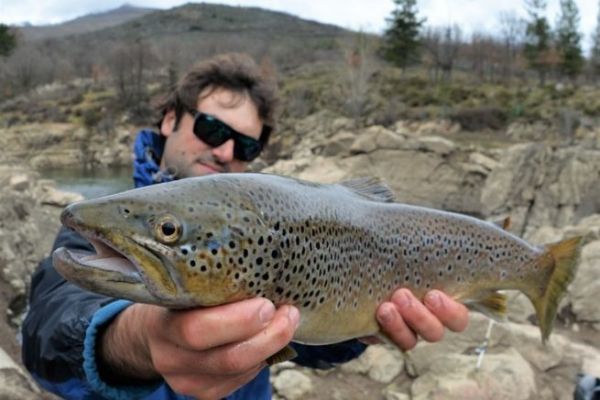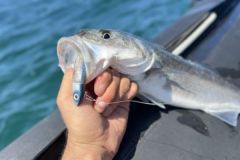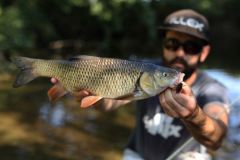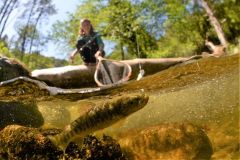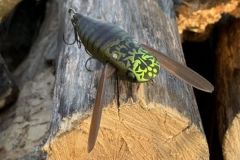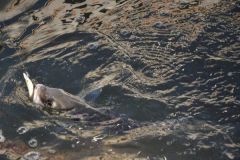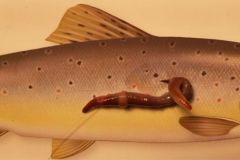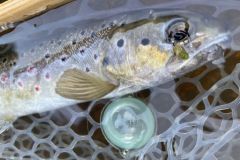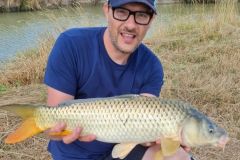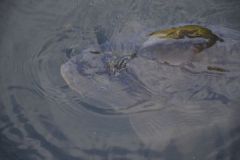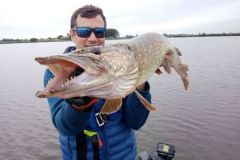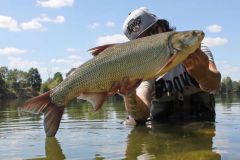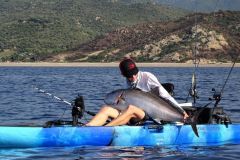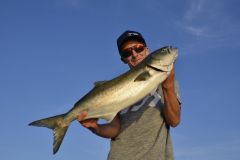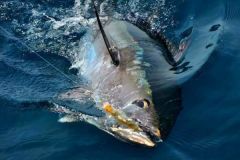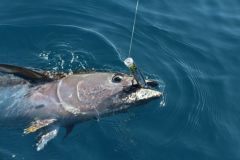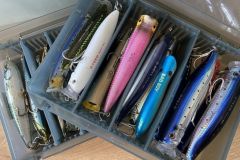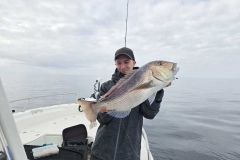The biotope is a determining factor in the search for large trout. They are unrivalled predators and are therefore highly receptive to lures. Let's take a look at how to develop a strategy to track large trout with lures.
The right biotope for big fish
Catching a big trout is rarely a matter of chance. The first factor to consider is the biotope. Big trout are often found where the environment is conducive to rapid growth. To tackle big trout, you first need to find places that are home to as many beautiful fish as possible.
Most regions have at least one spot renowned for catching fine salmonids. Biotope research is the key to catching large salmonids. Specimens are often found in large rivers, known as piedmont rivers (located in large valleys), where beautiful fish thrive. These rivers are fed by numerous cool, oxygenated streams and have a lively current all year round.
It is quite rare to find specimens in small mountain streams that dry up in summer and flood in winter. In addition to these foothill rivers, which are home to large sedentary trout, it is also possible to find fine migratory specimens in many rivers flowing into high-altitude lakes. These are sea or lake trout that migrate upstream to reproduce. Some lakes, notably reservoirs, are also home to a large, fast-growing salmonid population.
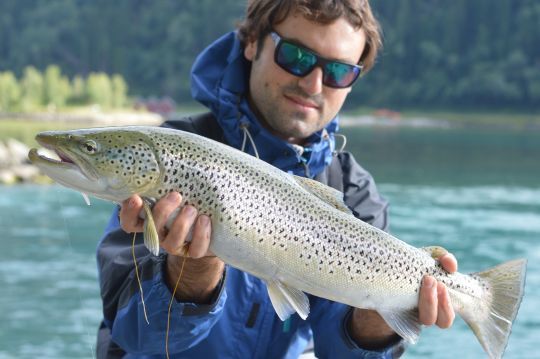
In addition to the size of the watercourse or the volume of the body of water, it's the density of food and the richness of the site that directly impacts trout size, particularly the presence of small fish. For these trout are inveterate predators and particularly ichthyophagous (fish-eaters).
Although they remain opportunistic and omnivorous, they feed heavily on small fish such as minnows, gudgeon and other small cyprinids or sculpins, and even trout! Their jaws are correspondingly developed, with sharp teeth and a wide-slit mouth. They are precise predators whose diet consists mainly of fish. A godsend for lure anglers!
Lure fishing for large trout
To lure these predators, lure fishing is just the thing. These large trout have a predatory diet, but also the aggressiveness that characterizes the behaviour of many predators.
They are therefore doubly receptive to lures: on the one hand, because they resemble the usual prey, and on the other, because they incite an aggressive attack. To select beautiful trout, you need to use larger lures than those normally used for stalking our speckled trout.
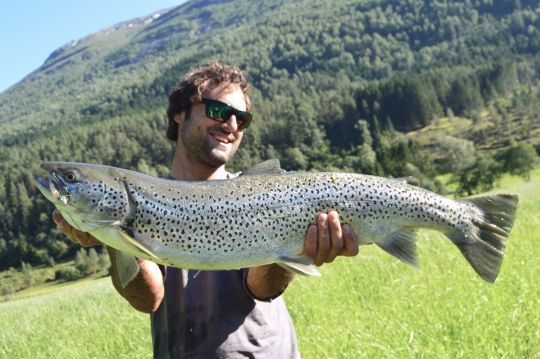
Minimum size is 65 mm to 100 mm. Minnow and jerkbait swimbaits are the best choice. Sinking models, whose density is greater than that of the water, are ideal for fishing currents and hollows.
For my part, I like very punchy animations, composed of powerful jerks and quick retrieves. In this way, I act on the reflex mechanism of these predators, which often pushes these big trout to attack.
In addition to swimming fish, I also use soft lures. Here again, fish imitations are preferred. Shads on lead heads are effective when fishing heavy downstream. I prefer finesse lures, however, for their ability to imitate and incite fish. They are relatively versatile and have the real ability to trigger bites where others leave fish sceptical.
In any case, don't hesitate to "spin your box" to find out which lure is the most effective in the target area.
Fishing
Once you've chosen the river or lake, it's not enough to cast relentlessly to trigger a big fish. Salmonids, especially specimens, remain wary fish even if they are aggressive. Your approach must be discreet.
Swimming fish and dense lures, in addition to their ability to fish well in hollows and overcome currents, are precious allies for casting far without being spotted. Big trout spots are often well-marked pools and veins of hollow water. These are the positions offering the most comfort for the fish: oxygenated water, volume, food... It's not uncommon to trigger a big trout by sweeping the position several times.
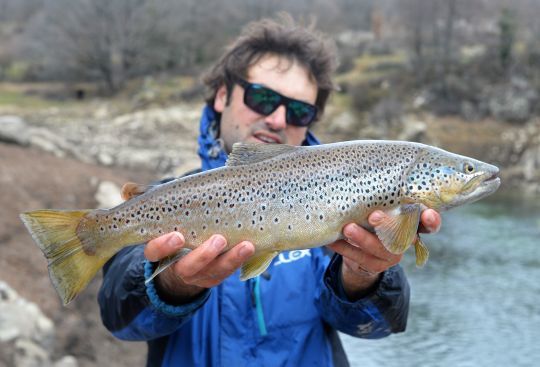
So don't hesitate to insist on positions that seem promising. And don't forget to get off the beaten track. The less frequented the spots, the more the fish will lower their guard. This is a factor to be taken into account if you want to give yourself the best chance of fooling a big fish.
Substantial but light equipment...
The choice of tackle is quite particular. The lures are nothing exceptional in terms of size and weight compared with those used for other predators such as pike. However, you'll need a rod that's up to the task of fighting super-powered salmonids that can reach well over 80 cm... Sometimes even in full current.
A well-built ML rod with MH seems to me to be the right compromise between being able to cast and animate lures weighing 10 to 20 grams and conquer fish weighing over 6 kg. I use the Illex Pepper S210ML Akoya Pearl or The Artist S225M Black Ops.
As for the reel, here too the choice is limited: a good 2500 to 3000 filled with 24/100 nylon or PE0.8 braid (resistance of around 12 lbs, or just under 6 kg) allows you to work some fine specimens.
Apart from the rod and reel, I must also stress the need for a landing net. This should have a wide opening to allow large, powerful trout to enter easily. It will enable you to shorten the fight and ensure the capture of a fish that could be one of the biggest of your life and, above all, guarantee your trophy trout's chances of survival. Moreover, these fish are rather delicate to handle (little grip in the gills, difficulty in holding them by the mouth...) and relatively fragile!
The "reservoir" case
Different fishing, different approach. Reservoir fishing, also known as "area" fishing, is booming in France. Often reserved for fly fishing, they are gradually opening up to lure fishing. For many anglers, this is a real opportunity to catch a big salmonid.
In fact, these reservoirs are regularly stocked with fish of all sizes, including a number of record-breakers, to boost the appeal of these water features. Rainbow trout are queens in these enclosed waters and make powerful, pugnacious opponents.
But don't be fooled into thinking that fishing here is easy. These well-educated fish are constantly on the move and are constantly being fished by lures. You'll have to play it smart and fish subtly to catch a trophy salmonid. Wobbling spoons are true "sauves bredouilles" combining attractiveness and simplicity.
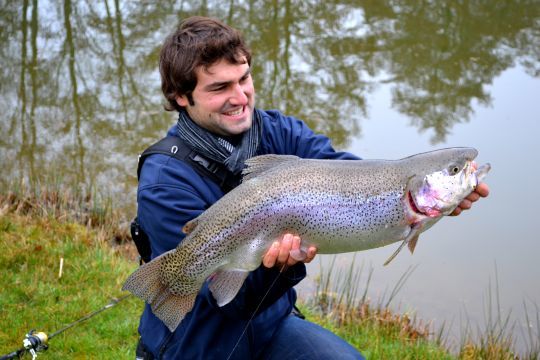
They allow you to fish hollow and slow, evolving in a natural way. During peaks of activity, surface lures and small crankbaits can be a great way to seduce a big rainbow. I won't go into the vast subject of "area" fishing, which deserves an article of its own, but you should know that it's a real way of catching a specimen that really deserves to be caught.

 /
/ 